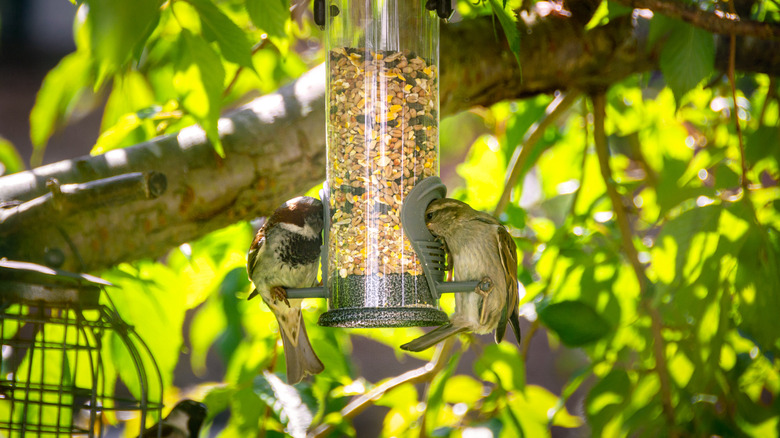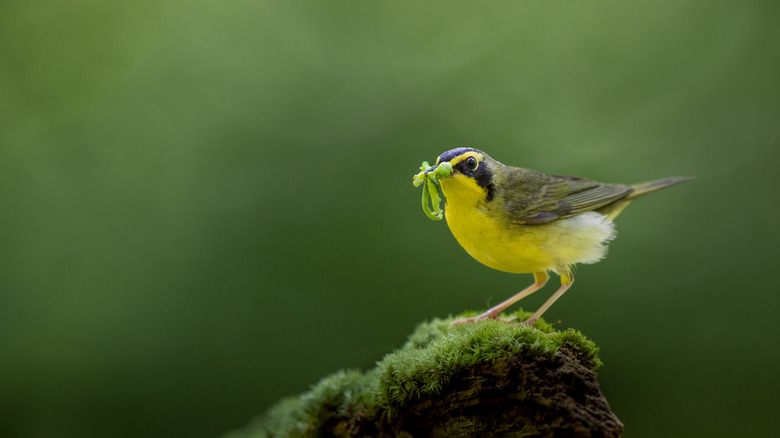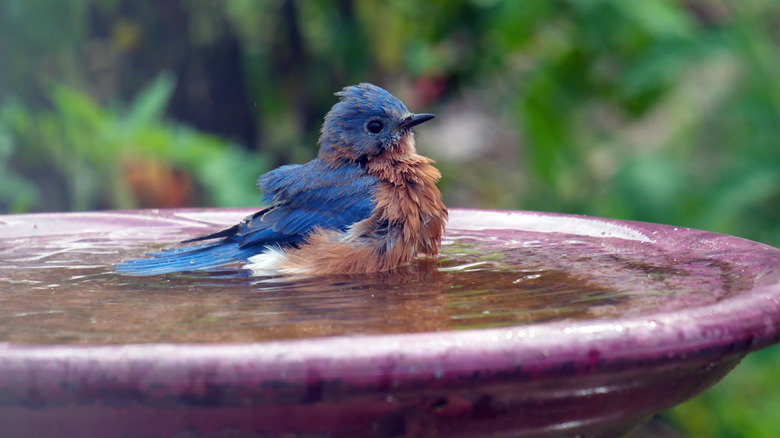Use Bird Feeders For A Clever Garden Defense System
All gardeners know that issues with insects are inevitable, but luckily, birds can be an eco-friendly way to keep bugs out of your garden. By setting up a variety of bird feeders, you can attract even more of these feathered friends to your yard. Birds are notorious predators for all kinds of insects throughout their life stages, and the more of them that frequent your outdoor space, the more insects they'll eat. Because different species of birds tend to favor certain insects, you'll want to make sure you're offering wide varieties of food with different types of feeders. For example, if you're having issues with aphids, beetles, or caterpillars, you may want to try to attract warblers, titmice, or chickadees. On the other hand, bluebirds are known to go after mosquitoes, snails, termites, spiders, and more.
Having many birds of different species frequenting the feeders in your yard and around your lawn can have a big impact on the insects as well. While birds will eat from the feeders, they are likely to stick around and pick at the bugs in your yard as well, especially if they're feeding their babies. Providing access to water and shelter will also encourage birds to stay and munch on pesky insects.
Using bird feeders to defend against insects
To ensure that you're receiving as many different types of birds as possible, you'll want to give them various options for food as well as places to eat. Once your feathered friends start picking off insects, you'll begin to notice the benefits of having a bird feeder in your yard. If you're trying to attract chickadees to ward off whiteflies or earwigs, tube feeders are a great option as they're favored by smaller birds. On the other hand, platform feeders can support bigger species as well as smaller ones. Suet feeders can also be helpful for attracting birds that eat insects, like woodpeckers, though you have to be careful not to let them melt or spoil in the summer heat.
While many birds will eat seeds, you might also consider offering other options, such as mealworms or fruit. Orange slices work well for bringing around more orioles, which often eat beetles, caterpillars, spiders, and some insect larvae. You'll also want to be sure you're placing your feeders in different spots around your garden. Having your feeders about 10 feet from thick brush or the woods can also help to make it feel safer for your feathered friends, as it gives them a place to hide if predators approach.
Bring birds to your garden for a clever defense system
Besides providing a buffet of different foods around your garden, you might also consider giving your feathered friends a place to drink and rest. Birdbaths are a great way to support these insect predators and encourage them to stay close by. Adding a bubbler or fountain to your birdbath could make it easier to attract birds to your garden, since these animals prefer moving water. Make sure to put fresh water into the bath every few days.
Though different birds will nest at different times of year, having a few birdhouses around will give local birds options of where to live. If they choose to nest in a birdhouse near your garden, they're very likely to scavenge your lawn for bugs to feed to their growing babies. Both swallows and house wrens nest in the summer, while some species of chickadee will stay in a birdhouse all year. By positioning a few birdhouses with 1 ¼-inch openings around your garden, you can invite small, bug-eating birds to take care of the insects in your outdoor space. By having birdbaths and houses in addition to feeders, you can be sure your feathered friends will stop by to grab a few pesky bugs from your garden.


